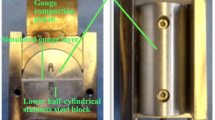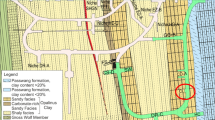Abstract
Geochemical interactions of brine–rock–gas have a significant impact on the stability and integrity of the caprock for long-term CO2 geological storage. Invasion of CO2 into the caprock from the storage reservoir by (1) molecular diffusion of dissolved CO2, (2) CO2-water two-phase flow after capillary breakthrough, and (3) CO2 flow through existing open fractures may alter the mineralogy, porosity, and mechanical strength of the caprock due to the mineral dissolution or precipitation. This determines the self-enhancement or self-sealing efficiency of the caprock. In this paper, two types of caprock, a clay-rich shale and a mudstone, are considered for the modeling analyses of the self-sealing and self-enhancement phenomena. The clay-rich shale taken from the Jianghan Basin of China is used as the base-case model. The results are compared with a mudstone caprock which is compositionally very different than the clay-rich shale. We focus on mineral alterations induced by the invasion of CO2, feedback on medium properties such as porosity, and the self-sealing efficiency of the caprock. A number of sensitivity simulations are performed using the multiphase reactive transport code TOUGHREACT to identify the major minerals that have an impact on the caprock’s self-sealing efficiency. Our model results indicate that under the same hydrogeological conditions, the mudstone is more suitable to be used as a caprock. The sealing distances are barely different in the two types of caprock, both being about 0.6 m far from the interface between the reservoir and caprock. However, the times of occurrence of sealing are considerably different. For the mudstone model, the self-sealing occurs at the beginning of simulation, while for the clay-rich shale model, the porosity begins to decline only after 100 years. At the bottom of the clay-rich shale column, the porosity declines to 0.034, while that of mudstone declines to 0.02. The sensitive minerals in the clay-rich shale model are calcite, magnesite, and smectite-Ca. Anhydrite and illite provide Ca2+ and Mg2+ to the sensitive minerals for their precipitation. The mudstone model simulation is divided into three stages. There are different governing minerals in different stages, and the effect of the reservoir formation water on the alteration of sensitive minerals is significant.









Similar content being viewed by others
References
Al-Basali TM, Zhang J, Sharma MM (2005) Measurement of the sealing capacity of shale caprocks. In: SPE annual technology conference and exhibition, Houston, Texas, 9–12 Oct 2005, SPE 96100
Bachu S, Didier B, John B, Burruss R, Holloway S, Christensen NP, Mathiassen OM (2007) CO2 storage capacity estimation: methodology and gaps. Int J Greenh Gas Control 1(4):430–443
Bowden AR, Rigg A (2005) Assessing reservoir performance risk in CO2 storage projects. Greenh Gas Control Technol 7(1):683–691
Busch A, Alles S, Gensterblum Y, Prinz D, Dewhurst DN, Raven MD, Stanjek H, Krooss BM (2008) Carbon dioxide storage potential of shales. Int J Greenh Gas Control 2:297–308
Ceila MA, Bachu S, Nordbotten JM, Kavetski D, Gasda S (2006) A risk assessment tool to quantify CO2 leakage potential through wells in mature sedimentary basins. Paper presented at the 8th international conference on Greenhouse Gas Control Technologies, Trondheim, Norway, June
Chang WK, Bryant SL (2007) Dynamics of CO2 plumes encountering a fault in a reservoir, presented at the 6th annual conference on carbon capture and sequestration, Pittsburgh, Pensylvania, 7–10 May
Chiquet P, Broseta D, Thibeau S (2007) Wettability alteration of caprock minerals by carbon dioxide. Geofluids 7:112–122
Dong J, Li Y, Yang G, Ke Y, Wu R (2012) Numerical simulation of CO2-water–rock interaction impact on caprock permeability. Geol Sci Technol Inf 31(1):115–121
Ennis-King J, Paterson L (2000) Reservoir engineering issues in the geological disposal of carbon dioxide. In: Williams DJ, Durie RA, McMullan P, Paulson CAJ, Smith AY (eds) 5th International conference on Greenhouse Gas Control Technologies, Cairns, Australia, pp 290–295
Fleury M, Pironon J, Le Nindre YM, Bildstein O, Berne P, Lagneau V, Broseta D, Pichery T (2010) Evaluating sealing efficiency of caprocks for CO2 storage: an overview of the geocarbone integrity program and results. Oil Gas Sci Technol 65:435–444
Fleury M, Pironon J, Nindre YML, Bildstein O, Berne P, Lagneau V, Broseta D, Pichery T, Fillacier S, Lescanne M (2011) Evaluating sealing efficiency of caprocks for CO2 storage: an overview of the geocarbone integrity program and results. Sci Direct 4:5227–5234
Gaus I (2010) Role and impact of CO2–rock interactions during CO2 storage in sedimentary rocks. Int J Greenh Gas Control 4:73–89
Gaus I, Azaroual M, Czernichowski-Lauriol I (2005) Reactive transport modelling of the impact of CO2 injection on the clayey caprock at Sleipner (North Sea). Chem Geol 217:319–337
Gherardi F, Xu TF, Pruess K (2007) Numerical modeling of self-limiting and self-enhancing caprock alteration induced by CO2 storage in a depleted gas reservoir. Chem Geol 1–2(244):103–129
Gunter WD, Perkins EH, Hutcheon I (2000) Aquifer disposal of acid gases: modelling of water–rock reactions for trapping of acid wastes. Appl Geochem 15:1085–1095
Hildenbrand A, Schlomer S, Krooss BM, Littke R (2004) Gas breakthrough experiments on pelitic rocks: comparative study with N2, CO2 and CH4. Geofluids 4:61–80
Jiangling (2010) Research on the environmental impact of carbon dioxide geological sequestration on grounder water, a case study of Jianghan Basin. China University of Geosciences (Wuhan)
Labus K, Bujok P (2011) CO2 mineral sequestration mechanisms and capacity of saline aquifers of the upper Silesian Coal Basin (Central Europe)—modeling and experimental verification. Energy 36:4974–4982
Lasaga AC (1984) Chemical kinetics of water–rock interactions. J Geophys Res 89:4009–4025
Lindeberg E (1997) Escape of CO2 from aquifers. Energy Convers Manag 38(SUPPL.1):S235–S240
Lindeberg E (2003) The quality of a CO2 repository: what is the sufficient retention time of CO2 stored underground. In: Gale J, Kaya Y (eds) Proceedings of the 6th international conference on Greenhouse Gas Control Technologies, 1, pp 255–266
Liu F, Lu P, Griffith C, Hedges SW, Soong Y, Hellevang H, Zhu C (2012) CO2-brine-caprock interaction: reactivity experiments on Eau Claire shale and a review of relevant literature. Int J Green Gas Control 7:153–167
Narasimhan TN, Whiterspoon PA (1976) An integrated finite difference method for analyzing fluid flow in deformable porous media. Water Resour Res 12:57–64
Palandri JL, Kharaka YK (2004) A compilation of rate parameters of water–mineral interaction kinetics for application to geochemical modeling. US Geological Survey Open File Report 1068, p 64
Parkhurst DL, Thorstenson DC, Plummer LN (1980) PHREEQE: a computer program for geochemical calculations. US Geological Survey Water Resources Investigations Report 174, pp 80–96
Pruess K (2008) Leakage of CO2 from geologic storage: role of secondary accumulation at shallow depth. Int J Greenh Gas Control 1(2):37–46
Pruess K, García J (2002) Multiphase flow dynamics during CO2 disposal into saline aquifers. Environ Geol 2–3(42):282–295
Pruess K, Oldenburg C, Moridis G (1999) TOUGH2 user’s guide, version 2.0. Lawrence Berkeley Laboratory Report LBL. 43134, Berkeley, CA
Reed MH (1982) Calculation of multicomponent chemical equilibria and reaction processes in systems involving minerals, gases and an aqueous phase. Geochim Cosmochim Acta 46:513–528
Rochelle CA, Czernichowski-Lauriol I, Milodowski AE (2004) The impact of chemical reactions in CO2 storage in geologic formations: a brief review. In: Baines SJ, Worden RH (eds) Geological storage of carbon dioxide. Geological Society special publication, 233:87–106
Rutqvist J, Tsang CF (2002) A study of caprock hydromel-chanical changes associated with CO2-injection into a brine formation. Environ Geol 2–3(42):296–305
Steefel CI, Lasaga AC (1994) A coupled model for transport of multiple chemical species and kinetic precipitation/dissolution reactions with applications to reactive flow in single phase hydrothermal system. Am J Sci 294:529–592
Van Genuchten MTh (1980) A closed-form equation for predicting the hydraulic conductivity of unsaturated soils. Soil Sci Soc Am J 44:892–898
Wolery TJ (1992) EQ3/6: software package for geochemical modeling of aqueous systems: package overview and installation guide (version 7.2). Lawrence Livermore National Laboratory Report UCRL-MA-10662 PT I, Livermore, CA
Xu T, Sonnenthal E, Spycher N, Pruess K (2004) TOUGHREACT user’s guide: a simulation program for non-isothermal multiphase reactive geochemical transport in variably saturated geologic media. Lawrence Berkeley National Laboratory Report LBNL-55460, Berkeley, CA
Xu T, Apps JA, Pruess K (2005) Mineral sequestration of carbon dioxide in a sandstone–shale system. Chem Geol 217:295–318
Xu T, Sonnenthal E, Spycher N, Pruess K (2006) TOUGHREACT- A simulation program for non-isothermal multiphase reactive geochemical transport in variably saturated geologic media: applications to geothermal injectivity and CO2 geological sequestration. Comput Geosci 32(2):145–165
Xu T, Spycher N, Sonnenthal E, Zhang G, Zheng L, Pruess K (2011) TOUGHREACT version 2.0: a simulator for subsurface reactive transport under non-isothermal multiphase flow conditions. Comput Geosci 37(6):763–774
Xu TF, Zheng LG, Tian HL (2011) Reactive transport modeling for CO2 geological sequestration. J Petrol Sci Eng 78(3–4):765–777
Zheng Y, Chen S, Zhang W et al (2009) Numerical simulation on geological storage of carbon dioxide in Jiangling depression, Jianghan Basin, China. Geol Sci Technol Inf 28(4):75–82
Acknowledgments
This work greatly benefited from Jilin University’s Groundwater Resources and Environments Key Laboratory of Ministry of Education (China), from China Scholarship Council and public welfare industry special funds for scientific research from Ministry of Land and Resources of China (Grant No. 201211063-06), from Graduate Innovation Fund of Jilin University (No. 20121069).
Author information
Authors and Affiliations
Corresponding author
Appendix
Appendix
Precipitation and dissolution of minerals are kinetically controlled. The kinetic laws used here are derived from transition state theory [19]. Effective reaction rates can be expressed through the following general equation:
where A m is the specific surface area, k m is the kinetic rate constant, Q is the ion activity product, K is the equilibrium constant for the specific mineral–water reaction, and μ and η are two constants which depend on experimental data; they are usually but not always taken equal to 1.
Kinetic rates may depend on the pH and also on concentrations of non-basis species. The temperature dependence of the reaction rate constant is expressed via an Arrhenius equation:
where E a is the activation energy, k 25 is the rate constant at 25 °C, R is gas constant, and T is the absolute temperature.
The TOUGHREACT code used in this work can model effects of supersaturation and nucleation phenomena by suppressing precipitation of a mineral up to a given, positive saturation index (SI) value. However, due to lack of reliable data, we did not invoke a “supersaturation window,” instead, minerals will start to precipitate as soon as SI > 0. The initial effective surface area of minerals not present at the start of a simulation is assigned as equivalent to those spheres with radius 10−5 m [35].
Rights and permissions
About this article
Cite this article
Tian, H., Xu, T., Wang, F. et al. A numerical study of mineral alteration and self-sealing efficiency of a caprock for CO2 geological storage. Acta Geotech. 9, 87–100 (2014). https://doi.org/10.1007/s11440-013-0225-8
Received:
Accepted:
Published:
Issue Date:
DOI: https://doi.org/10.1007/s11440-013-0225-8




